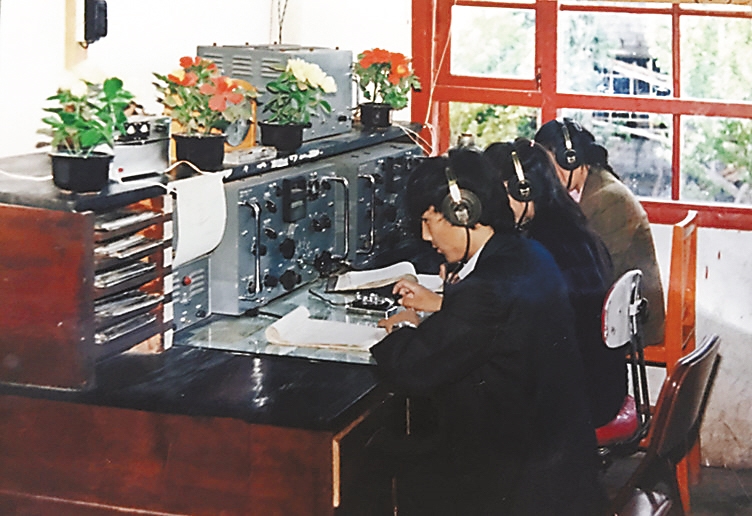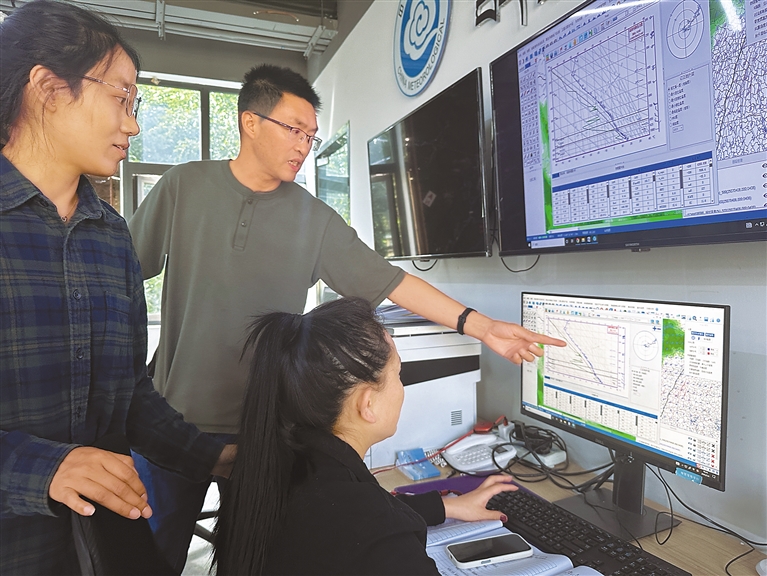Source:xzxw.com 2025-07-22

In the 1970s and 1980s, meteorological workers transmitted weather data via Morse code radio.

Pan Guiyuan (center) discussing meteorological operations with colleagues.
"This photo was taken inside that radar vehicle. Back then, we had to rotate this red dial to receive high-altitude signals from the 701 radar." Standing atop the Qamdo Meteorological Bureau building, Pan Guiyuan, director of the bureau’s Atmospheric Exploration Center, pointed to a corner of the observation field ahead. Turning around, he gently touched the GFE(L)1 wind-measuring radar, its silver-white metal casing glinting in the sunlight.
In 1995, Pan Guiyuan arrived at the Qamdo Weather Station, where conditions were harsh. The adobe hut could barely fit a bed—just a wooden plank placed atop two crates that creaked with every move. Observing clouds, measuring wind, and recording rain and snow relied entirely on the naked eye and manual labor. Data was jotted down in notebooks, calculations were hammered out on clunky calculators, and weather charts were painstakingly drawn by hand. The most nerve-wracking task was transmitting this precious data. Meteorologists huddled over antiquated Morse code radios, tapping out strings of beeps to convert the ever-changing skies of the eastern Tibetan plateau into coded messages."Sometimes the signal was so poor, we’d stomp our feet in frustration, terrified of missing something critical," Pan recalled, gazing at the old photo.
As time passed, a quiet technological revolution swept through this highland weather station. In 1999, the advent of computers ended the era of hand-drawn cloud maps."So much more convenient!" Pan marveled, looking at the array of modern equipment nearby. In 2001, a 2-megabit broadband connection was installed, allowing data to zip across in an instant. By 2005, a satellite reception system was in place, delivering crystal-clear cloud images from above. That same year, a Finnish-made VAISALA automatic weather station began operating alongside manual observation posts.
On December 31, 2008, a historic milestone was reached: Qamdo Weather Station transitioned to fully automated operations, marking the dawn of automated ground observations. In 2011, a spacious new observation field was built on the site of an old apple orchard, nestled against towering mountains—an ideal "watchtower" for capturing every "breath" of the sky.
Technological progress serves a singular purpose: to decode the language of the skies and safeguard lives on the plateau."The reconstruction of Bangda Airport, the construction of the Jinhe Power Station—none of it would’ve been possible without precise meteorological support," Pan listed, counting on his fingers."Then there’s the annual Kham Cultural Arts Festival, farmers’ spring planting and autumn harvests, summer rainstorms and floods, winter snowstorms blocking mountain passes… None of it happens without us ‘sky watchers’ forecasting the weather." He added,"One accurate blizzard warning might save a herder’s livestock; a timely rain forecast could rescue a field of barley on the brink of drought." His words underscored the weighty responsibility borne by meteorologists.
"Meteorological work demands split-second precision, down to the millimeter. " Pan said.Standing on the new observation field, he gazed into the distance. Below, the city of Qamdo bustled with activity; above, silver instruments gleamed in the sunlight. After 30 years of guarding Qamdo’s skies, this "veteran" is nearing retirement."But generation after generation of Qamdo meteorologists will remain, steadfast as the snow-capped mountains," Pan’s voice echoed in the mountain breeze.
In the office, young technicians click their mice, watching satellite maps shift in real time, tracking rain and snow across the Jinsha, Lancang, and Nujiang river basins. What brings Pan the most joy is seeing new university graduates deftly operate equipment he could once only dream of. From the clicks of Morse code to the silent speed of 5G, from rudimentary computers to supercomputers—the tools evolve, the technology leaps, but the unwavering devotion of these "sky watchers" remains, as enduring as the mountains themselves.
Reporters: Zhou Tingting, Phuntsok Namgyal
Translator: Liu Fang
Review: Purbu Tsering, Drakpa Wangchen
Copyright © Xizang Daily & China Xizang News All rights reserved
Reproduction in whole or in part without permissions prohibited
Index Code: 藏 ICP 备 05000021 号
Producer: Xizang Daily International Communication Center